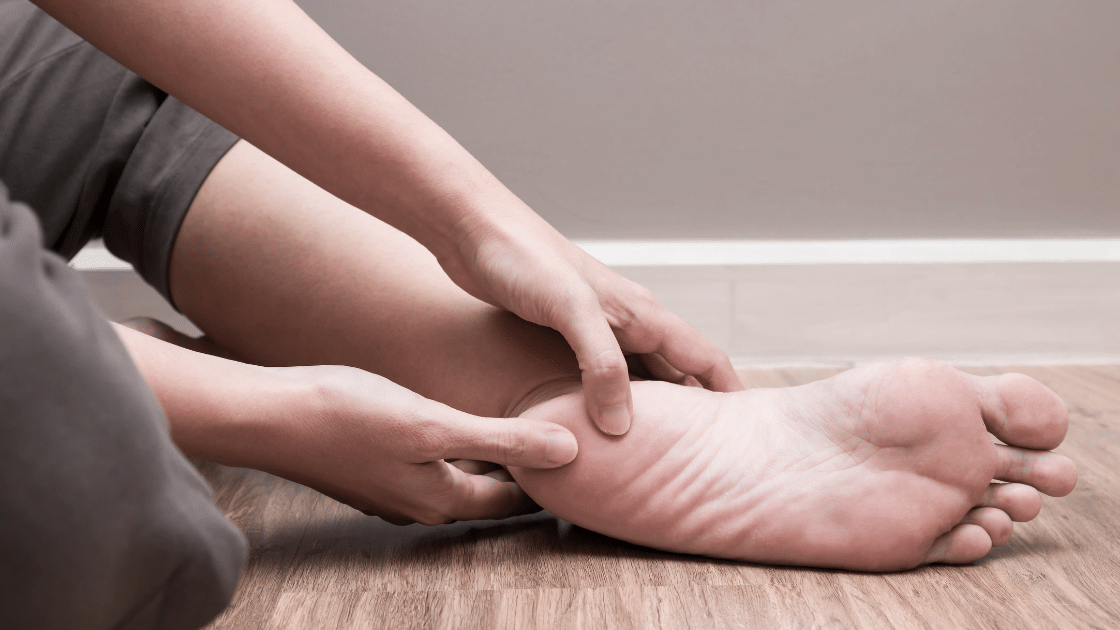Plantar Fasciitis

There’s a stabbing burning pain on the bottom of your heel. You felt it as soon as you planted your foot on the ground as you got out of bed. Not thinking much of it at first, you’ve noticed it’s still stabbing four weeks later. Hmmm, you say. What is going on? And can it be quelled?
If you’re an avid runner and/or wear shoes that are falling apart, you’re more likely to experience the scenario I just described. Plantar fasciitis, if anything I just said sounds familiar, may have crept its way into your shoe and onto your foot. Though treatable and very common, it really is unpleasant and makes you resent those shoes you refused to part with for all those years.
I’ve given you the name of it, but what exactly is plantar fasciitis? And what can be done for your poor old sole?
What is Plantar Fasciitis?
Any word that starts with the prefix plantar- involves the sole of the foot. Any word that ends in the suffix -itis involves inflammation.
Do you know that tough band of tissue that connects your heel to your toes? It’s called the plantar fascia, and you’ve angered it by overusing it. In response, the fascia has become inflamed. The repeated pressure, straining, and overstretching of this fibrous band has really done a number on the plantar fascia. It could be torn, swelling, bruised, and the only way it knows how to communicate this is to stab you in the foot. Sometimes the body has to be stern to let you know when something’s wrong, sadly.
Hearing all this, what can you do to let your fascia know it’s still loved?
Treatment for Plantar Fasciitis
If you google search “can plantar fasciitis go away on its own?”, you’ll find that the answer is “yes, it can”. But don’t just shrug it off and wait for it to fade away. Plantar fasciitis tends to stick around for six to eighteen months, and you up the chances of a longer battle if you just let it be. With consistent treatment, the vast majority of cases will resolve in that six-month period.
Stretching
Whether on your own or with assistance, stretching is key!
The plantar fascia ligament misses how strong and flexible it used to be. And of course, it also misses not being in pain. One way to improve all of those things is through stretching.
Here’s a video of a doctor who knows her stretches! If you have a belt or something similar, go get it for the first stretch she demonstrates! And if you have a water bottle, fetch that too! She shows you some self-massage techniques, and one of them involves a water bottle. (I have an article about the water bottle, can we attach it here?) (If you want to know more about how water bottles can ease your fascia, here’s an article I wrote about just that!)
Massage for Plantar Fasciitis
You saw a little bit of self-massage in that video above, but getting a massage from someone other than yourself is really the best! (But if you want to know about another good self-massage for plantar fasciitis, check out this article about tennis balls!)
Massage in general will break up the adhesions and relieve the pain, but it’s recommended to request a therapist who provides assisted stretching. Stretching, as mentioned above, is great for plantar fasciitis. But stretching is even more effective when the muscles have been loosened. And stretching while resisting against your therapist’s hand will better improve your strength and flexibility!
Chiropractic Care
It’s not just for spines, you know. Foot adjustments are a common and effective treatment for plantar fasciitis. When you view at Dr. Juris Shibayama website, you will know the benefits of chiropractic care, especially for spine and spinal injuries.
That being said, your chiropractor will likely treat other parts of your body to address the pain and dysfunction in your feet. If your gait is a little off and causing further injury to your plantar fascia, a spinal or leg adjustment can fix that. And to add some more overlap with the other two sections, a chiropractor can also mix assisted stretches and a bit of massage into an adjustment as well.
Physical Therapy
With physical therapy, you’ll be given strengthening exercises or treated with special tools for symptom relief.
Cold Therapy
Any type of inflammation will benefit from cold therapy. (That’s why your water bottle should be nice and cold before you massage yourself with it!)
Apply an ice pack to your foot for 10-15 minutes at a time, three to four times a day. The cold will constrict blood vessels and temporarily reduce blood flow to the impacted area, which will reduce the inflammation and swelling as well as the pain. If you don’t have an ice pack, use a bag of frozen vegetables or wrap some ice cubes in a towelette.
Rest
I know you want to continue running, but your plantar fasciitis doesn’t share that desire. Further abusing your plantar fasciitis will worsen the symptoms and make a longer road for recovery. Take this time to relax, and don’t be hard on yourself for the decreased physical activity. Ask your primary care provider when you’ll be safe to pound the pavement again.
Cortisone Injections
While these do reduce pain for a few months, they don’t actually address the root of the issue. For that reason, don’t just rely on cortisone injections if you choose to receive them. Also, note that your plantar fasciitis may be even more painful for a few days after the procedure.
Early Intervention is Important
All the treatments listed above are noninvasive and feel pretty nice. If you wait too long to seek treatment, you may require surgery. Regular massage and adjustments sound a lot better than having the plantar ligament sliced and needing assistance walking for a few weeks after.
Now you know what to do!
Stay happy, healthy, and get some self-care!

Katrina Jenkins
Author, Licensed Massage Therapist
Katrina Jenkins graduated from Towson University in 2013 with a Bachelor’s Degree in Health Science and worked as a nurse’s aide briefly before pursuing her true passion. She graduated from the Massage Therapy Institute of Colorado in April 2016 with honors and completed the Touch of Healers Scholarship Program the following summer. She has been a part of the Moyer Total Wellness Team since the summer of 2017.
Resources
Kadakia, Anish R. “Plantar Fasciitis and Bone Spurs.” OrthoInfo, AAOS, June 2010, orthoinfo.aaos.org/en/diseases–conditions/plantar-fasciitis-and-bone-spurs.
Mayo Clinic Staff. “Plantar Fasciitis.” Mayo Clinic, Mayo Foundation for Medical Education and Research, 11 Dec. 2019, www.mayoclinic.org/diseases-conditions/plantar-fasciitis/symptoms-causes/syc-20354846.
Tatli, Yusuf Ziya, and Sameer Kapasi. “The Real Risks of Steroid Injection for Plantar Fasciitis, with a Review of Conservative Therapies.” Current Reviews in Musculoskeletal Medicine, Humana Press Inc, 19 Sept. 2008, www.ncbi.nlm.nih.gov/pmc/articles/PMC2684947/.
Villines, Zawn. “Plantar Fasciitis Stretches: 6 Exercises and Other Home Remedies.” Medical News Today, MediLexicon International, 4 Feb. 2019, www.medicalnewstoday.com/articles/324353.
Photo Credit
Canva by catinsyrup
Canva by Marharyta Marko

